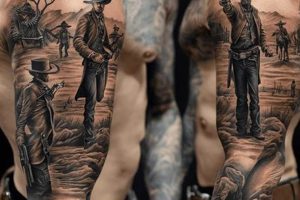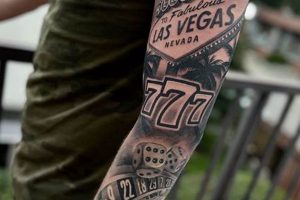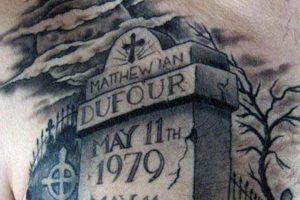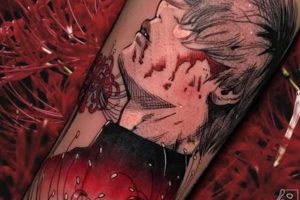Tattoos featuring macabre, supernatural, or generally unsettling imagery represent a popular aesthetic choice. Examples include depictions of ghosts, skeletons, haunted houses, gothic literature figures, or horror film icons, often rendered in dark, evocative styles. The spectrum of designs ranges from playfully creepy to genuinely terrifying, accommodating diverse interpretations of the “spooky” theme.
These designs offer individuals a powerful means of self-expression, allowing them to showcase their fascination with the darker aspects of life and fiction. They can serve as conversation starters, tributes to beloved characters or stories, or simply as visually striking body art. Historically, certain imagery associated with death, spirits, and the supernatural held cultural significance in various societies, sometimes serving as protective symbols or expressions of spirituality. This historical context adds further depth and resonance to the continued popularity of such themes in modern tattooing.
Exploring the numerous stylistic interpretations and specific design options available provides a deeper understanding of the enduring appeal and versatility of this tattoo genre. From classic horror movie monsters to intricate depictions of folklore creatures, a vast array of artistic possibilities awaits.
1. Imagery
Imagery forms the core of any successful spooky tattoo. The chosen visual elements dictate the specific emotion and narrative conveyed. A skeletal hand reaching from a grave evokes classic horror, while a raven perched on a skull suggests themes of death and mystery. Subtle imagery, like a lone, barren tree silhouetted against a blood-red moon, can create a lingering sense of unease and foreboding. The effectiveness of the imagery depends on its ability to resonate with the individual’s intended message and desired aesthetic.
Consider the difference between a realistic depiction of a zombie and a stylized, cartoonish version. The former emphasizes visceral horror and gore, while the latter might lean toward dark humor or a playful take on the macabre. Similarly, imagery derived from folklore, such as a banshee or a wendigo, carries specific cultural connotations and symbolic weight, adding layers of meaning beyond the purely visual. The selection of imagery, therefore, must be carefully considered based on the desired emotional impact and personal significance.
A successful spooky tattoo utilizes imagery that effectively communicates the intended message. Careful consideration of the specific visual elements and their inherent symbolism is crucial. Whether aiming for stark terror, playful creepiness, or a thought-provoking exploration of mortality, the imagery serves as the foundation upon which the entire design rests. Understanding the power and nuances of visual language within the context of spooky themes allows for the creation of a truly impactful and meaningful tattoo.
2. Style
Style significantly influences the overall impact of spooky tattoo ideas. A particular stylistic approach dictates the final aesthetic and emotional resonance of the design. Realism, for example, emphasizes detail and verisimilitude, creating visceral and sometimes unsettling effects, ideal for depictions of creatures or portraits of horror icons. A realistic rendering of a decaying zombie conveys a different feeling than a stylized, cartoonish interpretation. The former emphasizes gore and decay, playing on fears of infection and mortality, while the latter might inject humor or satire into the macabre. The stylistic choice significantly impacts the final message conveyed.
Other styles, like traditional American or Japanese, lend themselves well to specific spooky themes. Bold lines, solid colors, and iconic imagery associated with these styles can be effectively employed to create powerful and evocative spooky designs. Traditional American, with its history of skulls, daggers, and roses, provides a strong foundation for macabre themes. Japanese traditional, with its depictions of oni (demons) and yokai (supernatural creatures), offers a rich tapestry of existing iconography to draw upon. Furthermore, neo-traditional styles allow for more flexibility and personalization while retaining the core elements of traditional tattooing, offering a wider range of creative possibilities within a recognizable aesthetic framework.
Choosing the appropriate style is paramount. Matching the desired aesthetic with a style that complements the chosen imagery ensures a cohesive and impactful final product. A delicate, illustrative style might better suit a subtle, ethereal ghost than a bold, traditional approach. Ultimately, the stylistic choice informs the overall mood, tone, and message of the spooky tattoo, highlighting the importance of careful consideration during the design process. Understanding the nuances and capabilities of different styles allows for a more informed and effective realization of a spooky tattoo idea.
3. Placement
Placement significantly impacts the overall effect of spooky tattoo ideas. Strategic placement enhances the visual narrative and emphasizes the chosen imagery’s inherent symbolism. Consideration of body contours, visibility, and potential for future additions contribute to a cohesive and impactful design. Choosing the right location amplifies the tattoo’s message and ensures its effective integration with the body’s natural canvas.
- Concealment and Reveal
Certain placements enhance the element of surprise or mystery. A spider hidden behind the ear, a skull peeking from beneath a collarbone, or a ghostly figure glimpsed under a sleeve cuff add an element of intrigue. These hidden designs offer a private connection to the spooky theme, allowing for a personalized and less overt expression. They also create opportunities for unexpected reveals, adding a layer of depth and narrative to the tattoo’s presence.
- Emphasis through Movement
The natural movement of the body can enhance a spooky tattoo’s impact. A writhing serpent tattooed along the spine or a spectral hand reaching across the ribs gains dynamism with the wearer’s movements. This interactive element adds a layer of visual interest and can heighten the unsettling or eerie qualities of the design. Careful consideration of body mechanics ensures the tattoo’s fluidity and enhances its intended effect.
- Anatomical Integration
Integrating the design with the body’s natural contours further enhances the spooky effect. A ribcage tattoo incorporating skeletal elements, a bat wing design wrapping around the shoulder blade, or a spider web spun across the elbow utilize the body’s shape to amplify the imagery’s inherent symbolism. This approach creates a sense of seamlessness, making the tattoo appear as an extension of the body itself, thereby strengthening its visual impact.
- Scale and Composition
The size and complexity of the design dictate suitable placement. Large, intricate pieces depicting haunted houses or detailed portraits of horror figures require ample space, such as the back, chest, or thigh. Smaller, simpler designs, like a single raven or a minimalist skull, can be effectively placed on the wrist, ankle, or behind the ear. Careful consideration of scale ensures the design’s clarity and prevents overcrowding, allowing the imagery to resonate fully.
The interplay between placement and design elevates spooky tattoo ideas from mere decoration to powerful statements of personal expression. Strategic placement amplifies the chosen imagery’s emotional impact, creating a captivating and meaningful piece of body art. By thoughtfully considering the body as a canvas and understanding the interplay between image and location, individuals can achieve a truly effective and impactful spooky tattoo.
4. Color Palette
Color palettes play a crucial role in establishing the mood and impact of spooky tattoo ideas. Strategic color choices amplify the intended emotional response, whether aiming for stark terror, subtle unease, or a playful take on the macabre. The interplay of hues, saturation, and contrast significantly contributes to the overall aesthetic and narrative of the design.
- Monochromatic Mastery
Black and gray ink remains a staple for spooky tattoos, offering a timeless and versatile approach. Varying shades of gray create depth and dimension, lending themselves to intricate details in depictions of skulls, ghosts, or haunted landscapes. The absence of color can heighten the sense of mystery and foreboding, allowing the imagery to speak for itself with stark clarity. This classic palette suits various styles, from realism to illustrative, offering a powerful foundation for diverse spooky themes.
- Deep Reds and Dark Hues
Incorporating deep reds, purples, and greens introduces an element of visceral impact. These colors, often associated with blood, decay, and the supernatural, amplify the unsettling aspects of spooky imagery. A splash of crimson on a vampire’s fangs or a sickly green glow emanating from a zombie’s eyes heightens the sense of horror and danger. Strategic use of these colors adds a layer of visceral realism, enhancing the overall impact.
- Unexpected Vibrancy
Introducing vibrant, unexpected colors can create a striking contrast, adding a layer of surrealism or dark humor to spooky designs. A neon green skeleton or a pastel pink ghost subverts traditional expectations, injecting an element of playfulness into otherwise macabre themes. This approach allows for unique and personalized interpretations of spooky aesthetics, offering a broader range of creative possibilities.
- Color as Symbolism
Color choices can also contribute symbolic depth to spooky tattoo designs. Black traditionally represents death and mystery, while white symbolizes ghosts and spirits. Green often signifies decay and poison, while purple can evoke magic and the otherworldly. Understanding these symbolic associations allows for the creation of multi-layered designs with embedded meaning, enriching the overall narrative.
Effective color palette selection elevates spooky tattoo ideas, transforming them from simple illustrations into powerful visual narratives. Careful consideration of color’s emotional and symbolic impact ensures a cohesive and impactful design that resonates with the intended message. By understanding the interplay of hues and their potential to evoke specific responses, individuals can achieve truly captivating and meaningful spooky tattoos.
5. Artist Selection
Realizing effective spooky tattoo ideas requires careful consideration of artist selection. An artist’s skill, style, and experience significantly impact the final product’s quality and adherence to the envisioned design. Choosing an artist specializing in the desired aesthetic ensures the tattoo’s successful execution and lasting impact.
- Portfolio Examination
Thorough portfolio review reveals an artist’s proficiency in specific styles and their ability to render spooky themes effectively. Examining previous work showcasing similar imagery, like skulls, monsters, or macabre scenes, provides insights into their artistic capabilities and stylistic preferences. A portfolio demonstrating consistent high-quality work within the desired aesthetic indicates a higher likelihood of a successful outcome.
- Style Specialization
Different artists specialize in various tattooing styles. Matching the desired aestheticrealism, traditional, neo-traditional, illustrativewith an artist’s area of expertise ensures a cohesive and well-executed design. An artist specializing in photorealism might excel at portraits of horror icons, while an artist skilled in traditional American tattooing might be better suited for bold, iconic depictions of classic spooky imagery like skulls and daggers.
- Technical Proficiency
Technical skill encompasses line work, shading, color application, and composition. Evaluating an artist’s precision and attention to detail, especially within the context of spooky themes, is crucial. Clean lines, smooth shading, and vibrant color saturation contribute to a high-quality and visually impactful tattoo. An artist’s ability to effectively render textures like bone, decaying flesh, or flowing spectral forms significantly impacts the overall realism and effectiveness of the design.
- Communication and Collaboration
Open communication with the chosen artist ensures a shared understanding of the desired design and its intended message. A collaborative approach, involving discussions about imagery, placement, and color palette, allows for a personalized and well-executed tattoo that aligns with the individual’s vision. Effective communication facilitates the incorporation of personal elements and symbolic meanings, enhancing the tattoo’s overall significance.
Selecting the right artist represents a crucial step in realizing impactful and well-executed spooky tattoo ideas. A thorough assessment of an artist’s portfolio, style specialization, technical proficiency, and communication style ensures a successful collaboration and a final product that effectively translates the desired vision into a lasting piece of body art. This careful selection process contributes significantly to the overall quality, aesthetic, and personal meaning embedded within the spooky tattoo.
Tips for Effective Spooky Tattoo Designs
Achieving a truly impactful and meaningful spooky tattoo requires careful planning and consideration. These tips provide guidance for navigating the design process, ensuring a successful and satisfying outcome.
Tip 1: Research Thoroughly
Explore various spooky themes, imagery, and styles. Gathering inspiration from diverse sourcesclassic horror films, gothic literature, folklore, and existing tattoo designscultivates a well-informed vision. Understanding the historical and cultural context of chosen imagery adds depth and significance.
Tip 2: Prioritize Original Concepts
While drawing inspiration from existing designs is valuable, strive for originality. Personalizing the concept ensures a unique and meaningful tattoo. Incorporating individual elements or symbolic details elevates the design beyond mere imitation.
Tip 3: Consider Placement Carefully
Placement impacts visibility, composition, and the tattoo’s interaction with the body’s natural contours. Consider how the design will appear on a specific body part and how its visibility aligns with personal preferences. Strategic placement enhances both aesthetics and symbolism.
Tip 4: Choose the Right Artist
Selecting a skilled artist specializing in the desired style is paramount. Review portfolios, assess technical proficiency, and discuss the concept in detail. A strong artist-client relationship ensures the realization of the envisioned design.
Tip 5: Reflect on Longevity
Tattoos are permanent. Reflect on the chosen design’s long-term suitability and its potential resonance over time. Choosing imagery and styles with enduring appeal avoids future regret.
Tip 6: Plan for Aftercare
Proper aftercare ensures the tattoo’s longevity and vibrancy. Following the artist’s instructions diligently promotes healing and preserves the design’s integrity. Diligent aftercare protects the investment and maintains the desired aesthetic.
By adhering to these guidelines, individuals can navigate the design process with confidence, ensuring a spooky tattoo that resonates with personal meaning and stands the test of time. Careful planning and informed decisions contribute to a truly impactful and satisfying piece of body art.
These considerations set the stage for a fulfilling experience, culminating in a spooky tattoo that reflects individual style and passion for the macabre.
Frequently Asked Questions about Spooky Tattoos
This section addresses common inquiries regarding spooky tattoo designs, offering practical insights and clarifying potential concerns.
Question 1: How painful are spooky tattoos, especially larger, more intricate designs?
Pain levels vary based on individual pain tolerance, placement, and the tattoo’s size and complexity. Generally, areas with thinner skin or closer proximity to bone experience higher sensitivity. Discussing pain management options with the chosen artist can alleviate discomfort during longer sessions.
Question 2: Do certain spooky imagery choices carry specific cultural or symbolic meanings one should be aware of before getting a tattoo?
Numerous spooky images hold cultural and symbolic significance. Researching the chosen imagery’s historical and cultural context ensures informed decisions and avoids unintentional misrepresentation or appropriation of culturally sensitive symbols.
Question 3: How does one choose the right tattoo artist for a spooky theme, given the wide range of styles and specializations?
Reviewing artist portfolios focusing on spooky themes and desired styles helps identify suitable artists. Assessing technical skill, experience with specific imagery, and client testimonials informs the selection process.
Question 4: What are the typical costs associated with spooky tattoos, and what factors influence pricing?
Tattoo costs depend on size, complexity, artist experience, and studio location. Larger, intricate designs requiring multiple sessions incur higher costs. Consulting with potential artists provides detailed price estimates based on specific design requirements.
Question 5: What aftercare procedures are crucial for preserving the vibrancy and longevity of spooky tattoos, particularly those with intricate details or vibrant colors?
Following the artist’s aftercare instructions diligently is crucial for proper healing and color retention. Keeping the tattoo clean, moisturized, and protected from sun exposure ensures long-lasting vibrancy and prevents premature fading or infection.
Question 6: Can spooky tattoos be effectively covered up or removed if one’s preferences change over time?
Covering up or removing spooky tattoos presents challenges depending on the design’s size, color palette, and placement. Laser removal is an option, but complete removal might require multiple sessions and may not be entirely successful. Consulting with a tattoo removal specialist provides realistic expectations and potential solutions.
Careful consideration of these frequently asked questions ensures informed decisions and contributes to a positive and satisfying spooky tattoo experience.
Equipped with a deeper understanding, exploration of specific spooky tattoo design ideas awaits.
Spooky Tattoo Ideas
Exploration of spooky tattoo ideas reveals a rich tapestry of imagery, styles, and artistic possibilities. From classic horror figures to subtle, eerie depictions, these designs offer a powerful means of self-expression, allowing individuals to showcase their fascination with the darker aspects of life, fiction, and the supernatural. Careful consideration of imagery, style, placement, and color palette, alongside selecting a skilled artist, ensures a successful and impactful tattoo. Understanding the historical and cultural context of chosen imagery adds depth and meaning to these permanent works of art.
Spooky tattoo designs represent a captivating intersection of art, personal expression, and cultural fascination. These permanent markings serve as powerful statements, reflecting individual narratives and interpretations of the macabre. Thoughtful consideration of the design process, from concept to execution, ensures a meaningful and impactful piece of body art that resonates with the wearer for years to come.







